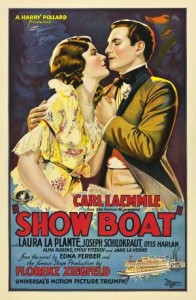Show Boat (1929 film)
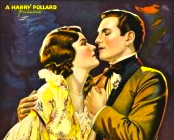
Show Boat (1929 Footage)
Show Boat is a 1929 American romantic drama film based on the novel of the same name by Edna Ferber, not, as has been often claimed, on the Kern-Hammerstein stage musical, although the film does have songs. This version was released by Universal in two editions, one a silent film for movie theatres still not equipped for sound, and one a part-talkie with a sound prologue. The storyline follows the novel rather closely, with the significant exception of the racial angle present in the novel and in virtually all other adaptations of it, including the celebrated 1927 Broadway musical version and the film versions of the musical, made, respectively, in 1936 and 1951. (Some live radio adaptations of the musical would also omit or heavily alter the racial angle.)
The 1929 film was long believed to be lost, but most of it has been found and released on laserdisc and shown on Turner Classic Movies. A number of sections of the soundtrack were found in the mid-1990s on Vitaphone records, although the film was made with a Movietone soundtrack. Two more records were discovered in 2005, and it was said these elements would be used for a 2007 DVD, but more than five years after that announcement, it has yet to appear.
Storyline
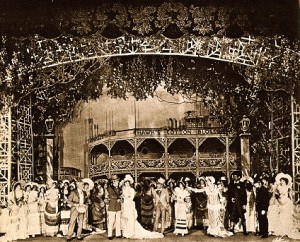 The 1929 film is not really an adaptation of the classic 1927 Kern–Hammerstein Broadway musical Show Boat, which was based on the same novel. Its plot line sticks much closer to the novel than to the stage production, but avoids the racial controversy that plays a prominent role in both Ferber’s novel and the Kern-Hammerstein Broadway show. On the other hand, it features risqué material related in the book but completely omitted from the Broadway musical adaptation, such as the depiction of a Chicago bordello.
The 1929 film is not really an adaptation of the classic 1927 Kern–Hammerstein Broadway musical Show Boat, which was based on the same novel. Its plot line sticks much closer to the novel than to the stage production, but avoids the racial controversy that plays a prominent role in both Ferber’s novel and the Kern-Hammerstein Broadway show. On the other hand, it features risqué material related in the book but completely omitted from the Broadway musical adaptation, such as the depiction of a Chicago bordello.
Following the novel, the film starts when Magnolia, the daughter of Captain Andy Hawks and his wife Parthy, is still a little girl. Unlike the musical, the scenes with Julie on the boat take place when Magnolia is still a child, while in the musical, they take place when she is eighteen.
In the 1929 film as in the novel, the eighteen-year-old Magnolia meets, falls in love with, and elopes with riverboat gambler Gaylord Ravenal. As in the novel, Cap’n Andy and Parthy die, whereas in the musical and the subsequent film versions based on it, all of the characters remain alive, despite the fact that the story spans forty years (in the novel, the span is a decade longer). After the death of Captain Andy, Magnolia, Ravenal, and their daughter Kim leave the boat and go to live in Chicago, where they live off Ravenal’s gambling earnings and are alternately rich and poor. Finally, Parthy announces she is coming to visit at a time when Ravenal is completely broke, and, fearing her wrath, he abandons Magnolia and Kim, after which Magnolia finds a job singing at a local club and eventually becomes famous. Years later, Parthy dies, and Magnolia, who had long been estranged from her because of her attitude toward Ravenal, returns to the show boat. In a nod to the stage musical, Magnolia and Ravenal are reunited on the show boat at the end of the 1929 film, whereas in the novel, Ravenal not only never returns to Magnolia, but dies in San Francisco, and after Parthy’s death Magnolia gives her own inheritance money to her daughter Kim.
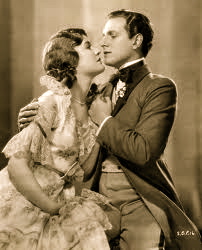 The interracial marriage between the mulatto actress Julie and her white husband Steve, the section of Ferber’s novel that made the stage musical so unusual for its time, was completely dropped from the 1929 film to appease censors and Southern audiences, and Julie in this version was not only made a white woman, but was evicted from the boat not because of her illegal marriage to a white man, but because of Parthy’s jealousy over her relationship with Magnolia (to whom Julie is a sort of surrogate mother and confidante). Years later, Julie becomes the madam of that Chicago bordello, not an alcoholic as in the musical, and the disappearance of her husband is left unexplained.
The interracial marriage between the mulatto actress Julie and her white husband Steve, the section of Ferber’s novel that made the stage musical so unusual for its time, was completely dropped from the 1929 film to appease censors and Southern audiences, and Julie in this version was not only made a white woman, but was evicted from the boat not because of her illegal marriage to a white man, but because of Parthy’s jealousy over her relationship with Magnolia (to whom Julie is a sort of surrogate mother and confidante). Years later, Julie becomes the madam of that Chicago bordello, not an alcoholic as in the musical, and the disappearance of her husband is left unexplained.
Cast and Crew
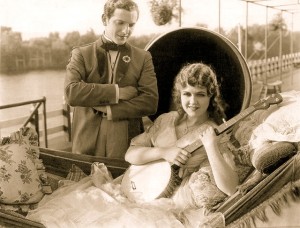 Laura La Plante and Joseph Schildkraut in a scene from the film.
Laura La Plante and Joseph Schildkraut in a scene from the film.
The film stars:
Laura La Plante as Magnolia Hawks
Joseph Schildkraut as Gaylord Ravenal
Emily Fitzroy as Parthenia ‘Parthy’ Ann Hawks
Otis Harlan as Capt’n Andy Hawks and the Master of Ceremonies in Prologue
Alma Rubens as Julie Dozier
Jack McDonald as Windy
Jane La Verne as Magnolia as a Child/Kim
Neely Edwards as Schultzy
Elise Bartlett as Elly
Stepin Fetchit as Joe
The story was adapted from Edna Ferber’s novel by Charles Kenyon, Harry A. Pollard, and Tom Reed. The film was directed by Pollard and produced by Carl Laemmle.
Sound adaptation
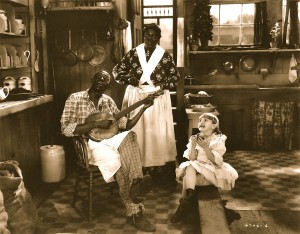 These were the years in which film studios were making a transition from silent films to sound films and this version of Show Boat was made as a silent film. The studio panicked when they realized that audiences might be expecting a sound version of Show Boat now that sound films had become so popular, and the film was temporarily withheld from release.
These were the years in which film studios were making a transition from silent films to sound films and this version of Show Boat was made as a silent film. The studio panicked when they realized that audiences might be expecting a sound version of Show Boat now that sound films had become so popular, and the film was temporarily withheld from release.
Subsequently, several scenes were then reshot to include about thirty minutes of dialogue and singing. At first, the songs recorded for the film had nothing to do with the Broadway score. However, Universal began to fear that audiences might instead be expecting, rather than just the Ferber novel, a film version of the stage musical, which had become a smash hit and was still playing on Broadway at the same time that the 1929 film premiered. So, a two-reel sound prologue, featuring original Broadway cast members Helen Morgan (Julie), Jules Bledsoe (Joe), Tess Gardella (Queenie) and the Jubilee Singers singing five songs from the show, was also added, and the movie was released both as a part-talkie and as a silent film without the prologue.
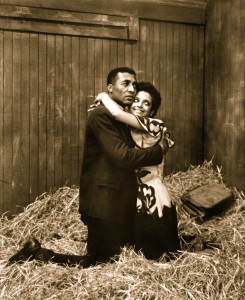 Otis Harlan, who played Cap’n Andy in the film, served as Master of Ceremonies in the prologue, which also featured legendary impresario Florenz Ziegfeld, producer of the stage musical version of Show Boat, and Carl Laemmle, the producer of the film, as themselves. In the actual storyline of the film, Laura la Plante, with a dubbed singing voice, performs five songs, two of them from the stage musical – “Ol’ Man River” (which Magnolia does not sing at all in any other version of Show Boat), and “Can’t Help Lovin’ Dat Man”. Both of these songs were sung in circumstances entirely different from any version of the musical. The other songs that Ms. La Plante sang in the film were traditional spirituals such as “I Got Shoes” and (it is believed) “Deep River”, as well as a coon song of the early 1900’s entitled “Coon Coon Coon”. Her singing voice was dubbed by soprano Eva Olivetti.
Otis Harlan, who played Cap’n Andy in the film, served as Master of Ceremonies in the prologue, which also featured legendary impresario Florenz Ziegfeld, producer of the stage musical version of Show Boat, and Carl Laemmle, the producer of the film, as themselves. In the actual storyline of the film, Laura la Plante, with a dubbed singing voice, performs five songs, two of them from the stage musical – “Ol’ Man River” (which Magnolia does not sing at all in any other version of Show Boat), and “Can’t Help Lovin’ Dat Man”. Both of these songs were sung in circumstances entirely different from any version of the musical. The other songs that Ms. La Plante sang in the film were traditional spirituals such as “I Got Shoes” and (it is believed) “Deep River”, as well as a coon song of the early 1900’s entitled “Coon Coon Coon”. Her singing voice was dubbed by soprano Eva Olivetti.
It was long believed that an entirely new score was written by Billy Rose for the film, but according to Miles Kreuger in his book Show Boat: The Story of a Classic American Musical, this turns out to not be true. Rose wrote only one new song for the film, and the Broadway score was not dropped because of any suggestion by him, as is often claimed.
The singing voice of Stepin Fetchit, who played Joe in the film, was provided by Jules Bledsoe, the original Joe of the 1927 stage production of the musical. Fetchit mouthed the lyrics to a popular song of the time entitled “The Lonesome Road”, which, as sung on the soundtrack by Bledsoe, served as the film’s finale instead of a final reprise of Ol’ Man River, as in the show.
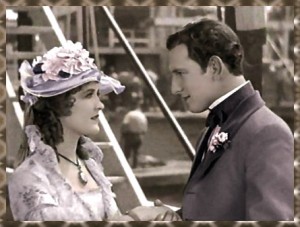 The entire stage score, except for Can’t Help Lovin’ Dat Man, Bill, Ol’ Man River, as well as the little-known songs C’mon Folks! (Queenie’s Ballyhoo) and Hey Feller!, were replaced in the 1929 film by several spirituals and popular songs written by other songwriters, and largely because of this, the movie was not a success. Most of the songs taken from the stage version were heard only in the prologue and in the film’s exit music, not the film itself. It is likely, though, that the fact that it was a part-talkie may have played a part in its failure. The then-recent 1929 film version of The Desert Song, an all-sound film almost literally faithful to the stage musical of the same name, had been a huge success, and audiences were no longer willing to accept part-talking musical films.
The entire stage score, except for Can’t Help Lovin’ Dat Man, Bill, Ol’ Man River, as well as the little-known songs C’mon Folks! (Queenie’s Ballyhoo) and Hey Feller!, were replaced in the 1929 film by several spirituals and popular songs written by other songwriters, and largely because of this, the movie was not a success. Most of the songs taken from the stage version were heard only in the prologue and in the film’s exit music, not the film itself. It is likely, though, that the fact that it was a part-talkie may have played a part in its failure. The then-recent 1929 film version of The Desert Song, an all-sound film almost literally faithful to the stage musical of the same name, had been a huge success, and audiences were no longer willing to accept part-talking musical films.
Several of the extant parts of the 1929 Show Boat have been combined and occasionally shown on Turner Classic Movies. Fragments of the prologue not included in the TCM showings – both sound and picture – were shown as part of the A&E’s biography of Florenz Ziegfeld, and have also turned up on YouTube. However, in the TCM version, the visual print of the Prologue sequence has been replaced with an “Overture” card.
Other information
This was the only one of the three film versions of Show Boat to run over two hours (the stage musical ran three hours originally). It was given a roadshow theatrical release with an intermission. The Broadway musical version, despite running three hours onstage, was filmed in 1936 and 1951 at a length of slightly less than two hours.

